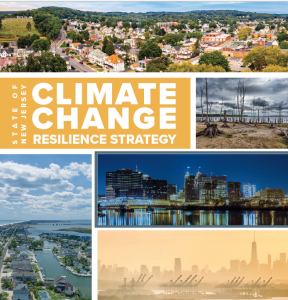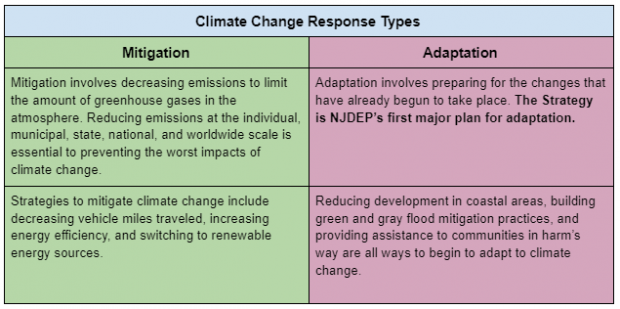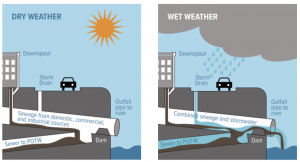New Jersey Future Blog
Strategizing from Sussex to Stone Harbor: Water Infrastructure in New Jersey’s Climate Strategy
July 19th, 2021 by Andrew Tabas

Figure 1: The Draft Climate Change Resilience Strategy describes the importance of preparing New Jersey’s drinking water, wastewater, and stormwater infrastructure for the effects of climate change.
When thinking about climate change in New Jersey, it is easy to focus on the most obvious threat: coastal flooding from sea level rise. However, climate change will have a number of effects on New Jersey’s drinking water, wastewater, and stormwater infrastructure as well. The New Jersey Department of Environmental Protection’s Draft Climate Change Resilience Strategy recognizes these issues and is an important first step toward adapting New Jersey’s drinking water, wastewater, and stormwater infrastructure for an uncertain future.
The New Jersey Department of Environmental Protection’s Draft Climate Change Resilience Strategy (“the Strategy”), released on April 22, 2021, is NJDEP’s first major step toward climate change adaptation, as opposed to mitigation. The focus on adaptation makes the Strategy “a critical recognition that climate change is here and will continue to impact our communities for decades to come,” according to New Jersey Future (NJF) Executive Director Pete Kasabach. Figure 2 explains the difference between mitigation and adaptation.

Figure 2: There are two main ways to respond to climate change: mitigation and adaptation. According to NJF Executive Director Pete Kasabach, the Draft Climate Change Resilience Strategy is the State’s first major policy document focused on adaptation.

Figure 3: Safe drinking water, which is essential to human health, is at risk due to saltwater intrusion, drought, and more intense storms that could damage infrastructure. Photo credit: Andrew Tabas.
The Strategy highlights several risks to drinking water infrastructure posed by climate change. First, flooding and storms can damage aging infrastructure. Second, current technology and standards were not set up to treat increased salt levels. Third, droughts, increased nonpoint source pollution (e.g., fertilizer runoff from farms), and saltwater intrusion could threaten water supply. To address these issues, New Jersey should invest in its drinking water infrastructure systems. Potential investments include increasing water efficiency, building new water storage, and relocating treatment plants, according to the Environmental Protection Agency’s website on climate impacts on water utilities. In its recommendations for the Strategy, NJF advocates for improved resilience training for drinking water and wastewater utility leaders and asks for more information on water infrastructure in future versions of the Strategy. Ensuring access to safe drinking water, one of the most important environmental justice issues, will protect public health across the state.

Figure 4: Combined Sewer Systems overflow during heavy rainfall events. Source: US Environmental Protection Agency.
Protecting and improving wastewater infrastructure in the face of climate change is essential as well. The Strategy notes that sewer systems must be elevated and protected from flooding. While this is an important issue, the Strategy does not discuss the risks of increased combined sewer overflows (CSOs). In towns with combined sewer systems, wastewater and stormwater enter the same pipes and are treated at wastewater treatment plants. During intense rain events, the volume in these pipes becomes too much for the treatment system to handle, so the sewage overflows directly into rivers, streets, and homes. As climate change brings more frequent and intense rainstorms, the risk of CSOs will increase. NJF recommends that future versions of the Strategy add a new action to address this issue: “incorporate climate change projections into CSO planning and forthcoming permits.” Smart planning in cities with combined sewer systems can reduce the negative health effects that come from exposure to sewage.

Figure 5: Bioswales and other types of green infrastructure can improve water quality, reduce nuisance flooding, and generate public health benefits. Image credit: AKRF, Inc., 2018.
The Strategy does an excellent job of addressing green infrastructure for stormwater management. Green infrastructure involves the use of practices that mimic the natural water cycle to capture stormwater and allow it to trickle into the ground. The Strategy highlights the benefits of green infrastructure, which include improving water quality, managing nuisance flooding, and improving public health. It is an encouraging sign that the Strategy highlights the importance of green infrastructure and emphasizes that it should be built first in the communities that need it most. NJF recommends three improvements to the Strategy’s treatment of stormwater. First, the Strategy should go beyond discussing the Stormwater Rule changes adopted in March 2020 by offering a preview of additional Stormwater Rule changes anticipated through the New Jersey Protect Against Climate Threats initiative. Second, the Strategy should describe a path forward for the implementation of Complete and Green Streets. Third, the Green Acres open space funding program has a beneficial opportunity to prioritize green infrastructure, as described by Jersey Water Works. These changes to the Strategy will help to bring the benefits of green infrastructure to communities across New Jersey.
Making drinking water, wastewater, and stormwater infrastructure resilient is essential for adapting to climate change. New Jersey’s Draft Climate Change Resilience Strategy offers promising first steps in all three of these areas. Read NJF’s full comments on the Climate Strategy to learn more.
Related Posts
Tags: climate change, drinking water, green infrastructure, water infrastructure
















